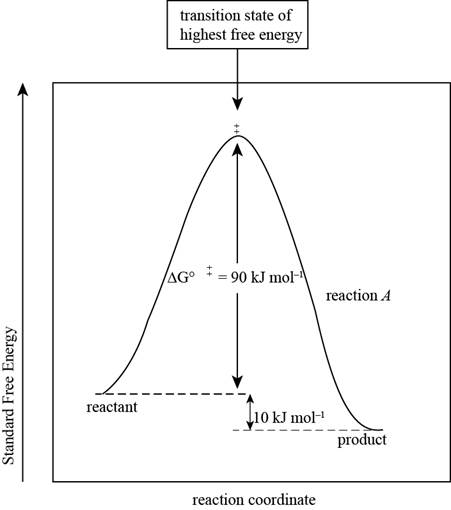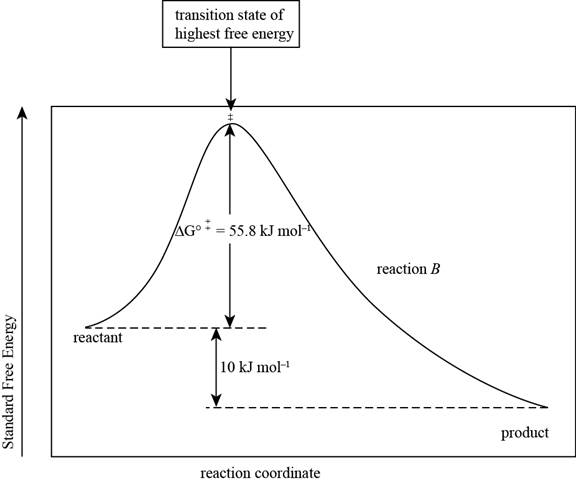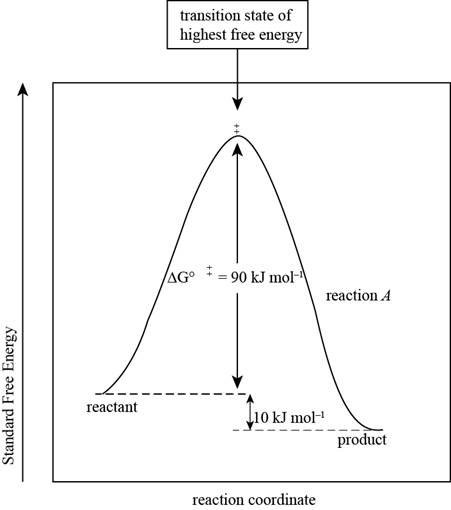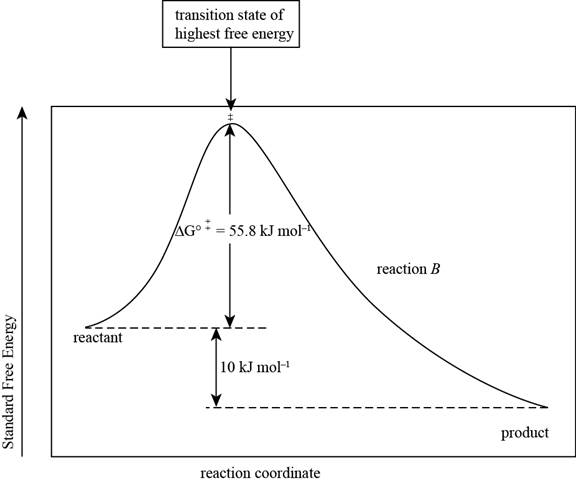
(a)
Interpretation:
The standard free energy of activation of reaction B is to be calculated.
Concept introduction:
The rate of the reaction is affected by the activation free energy of the reaction. The relationship between the activation free energy and
Where,
•
•
•
Answer to Problem 4.29P
The standard free energy of activation for reaction B is
Explanation of Solution
It is given that standard free energy of activation of reaction A is
The relative rates of two reactions are expressed as,
Where,
•
•
•
Substitute the activation energy for reaction A, the relative rate of A and B, gas constant and temperature in the given formula.
Rearrange the above equation for the calculation of activation energy of B as shown below.
Thus, standard free energy of activation for reaction B is
The standard free energy of activation for reaction B is
(b)
Interpretation:
The reaction free energy diagram for the two reactions showing the two values of
Concept introduction:
The transition state is formed during the conversion of reactants into products in the
Answer to Problem 4.29P
The reaction free-energy diagram for the reaction A showing the two values of

The reaction free-energy diagram for the reaction B showing the two values of

Explanation of Solution
It is given that standard free energy of activation of reaction A is
The reaction free-energy diagram for the reaction A showing the two values of

Figure 1
This diagram represents the plot between standard free energy and the reaction coordinates. The point at which the energy is maximum represents the transition state of the reaction.
The reaction free energy diagram for the reaction B showing the two values of

Figure 2
The reaction free-energy diagram for the two reactions showing the two values of
(c)
Interpretation:
The standard free energy of activation of the reverse reaction in both reactions A and B is to be calculated.
Concept introduction:
The free energy diagram represents the plot between standard free energy and the reaction coordinates. The point at which the energy is maximum represents the transition state of the reaction.
Answer to Problem 4.29P
The standard free energy of activation of the reverse reaction in both reactions A and B is
Explanation of Solution
It is given that standard free energy of activation of reaction A is
The products of each reaction are
The standard free energy of activation of the reverse reaction A is,
Thus, the standard free energy of activation of the reverse reaction A is
The standard free energy of activation of the reverse reaction B is,
Thus, the standard free energy of activation of the reverse reaction A is
The standard free energy of activation of the reverse reaction in both reactions A and B is
Want to see more full solutions like this?
Chapter 4 Solutions
Organic Chemistry
- Protecting Groups and Carbonyls 6) The synthesis generates allethrolone that exhibits high insect toxicity but low mammalian toxicity. They are used in pet shampoo, human lice shampoo, and industrial sprays for insects and mosquitos. Propose detailed mechanistic steps to generate the allethrolone label the different types of reagents (Grignard, acid/base protonation, acid/base deprotonation, reduction, oxidation, witting, aldol condensation, Robinson annulation, etc.) III + VI HS HS H+ CH,CH,Li III I II IV CI + P(Ph)3 V ༼ Hint: no strong base added VI S VII IX HO VIII -MgBr HgCl2,HgO HO. isomerization aqeuous solution H,SO, ༽༽༤༽༽ X MeOH Hint: enhances selectivity for reaction at the S X ☑arrow_forwardDraw the complete mechanism for the acid-catalyzed hydration of this alkene. esc 田 Explanation Check 1 888 Q A slock Add/Remove step Q F4 F5 F6 A བྲA F7 $ % 5 @ 4 2 3 & 6 87 Click and drag to start drawing a structure. © 2025 McGraw Hill LLC. All Rights Reserved. Terms of Use | Privacy Ce W E R T Y U S D LL G H IK DD 요 F8 F9 F10 F1 * ( 8 9 0 O P J K L Z X C V B N M H He commandarrow_forwardExplanation Check F1 H₂O H₂ Pd 1) MCPBA 2) H3O+ 1) Hg(OAc)2, H₂O 2) NaBH4 OH CI OH OH OH hydration halohydrin formation addition halogenation hydrogenation inhalation hydrogenation hydration ☐ halohydrin formation addition halogenation formation chelation hydrogenation halohydrin formation substitution hydration halogenation addition Ohalohydrin formation subtraction halogenation addition hydrogenation hydration F2 80 F3 σ F4 F5 F6 1 ! 2 # 3 $ 4 % 05 Q W & Å © 2025 McGraw Hill LLC. All Rights Reserved. F7 F8 ( 6 7 8 9 LU E R T Y U A F9arrow_forward
- Show the mechanism steps to obtain the lowerenergy intermediate: *see imagearrow_forwardSoap is made by the previous reaction *see image. The main difference between one soap and another soap isthe length (number of carbons) of the carboxylic acid. However, if a soap irritates your skin, they mostlikely used too much lye.Detergents have the same chemical structure as soaps except for the functional group. Detergentshave sulfate (R-SO4H) and phosphate (R-PO4H2) functional groups. Draw the above carboxylic acidcarbon chain but as the two variants of detergents. *see imagearrow_forwardWhat are the reactions or reagents used? *see imagearrow_forward
- The two pKa values of oxalic acid are 1.25 and 3.81. Why are they not the same value? Show the protontransfer as part of your explanation. *see imagearrow_forwardасть Identify all the bonds that gauche interact with C-OMe in the most stable conformation of the above compound.arrow_forwardPredict the reactants used in the formation of the following compounds using Acid-Catalyzed dehydration reactionarrow_forward
 Chemistry: Principles and ReactionsChemistryISBN:9781305079373Author:William L. Masterton, Cecile N. HurleyPublisher:Cengage Learning
Chemistry: Principles and ReactionsChemistryISBN:9781305079373Author:William L. Masterton, Cecile N. HurleyPublisher:Cengage Learning
